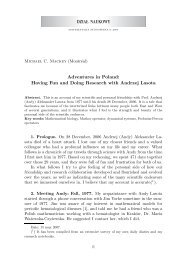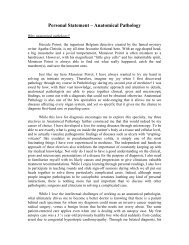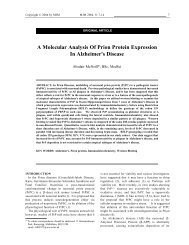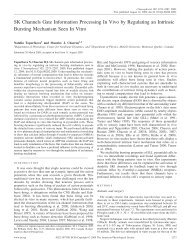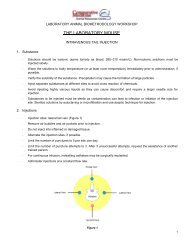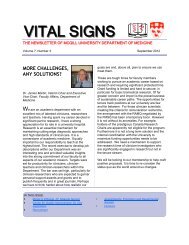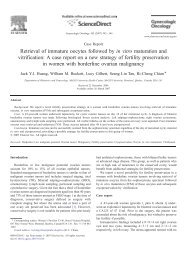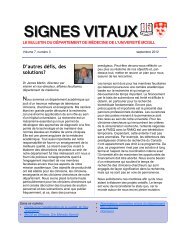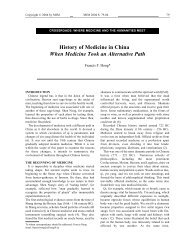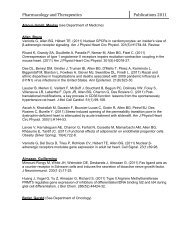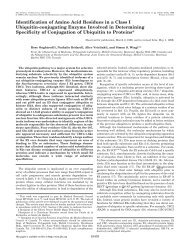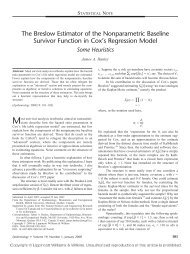GeoSentinel - Faculty of Medicine
GeoSentinel - Faculty of Medicine
GeoSentinel - Faculty of Medicine
Create successful ePaper yourself
Turn your PDF publications into a flip-book with our unique Google optimized e-Paper software.
<strong>GeoSentinel</strong>:<br />
<strong>GeoSentinel</strong><br />
The Global Surveillance<br />
Network <strong>of</strong> the ISTM and CDC<br />
A worldwide<br />
communications and<br />
data collection network<br />
<strong>of</strong> travel/tropical<br />
medicine clinics<br />
www.geosentinel.org
CME FACULTY DISCLOSURE<br />
Dr. Freedman<br />
has no affiliation with the manufacturer <strong>of</strong> any commercial<br />
product or provider <strong>of</strong> any commercial service discussed in<br />
this CME activity.
Provider-based Provider based Sentinel Surveillance<br />
The 3 Functions <strong>of</strong> <strong>GeoSentinel</strong><br />
1. Surveillance – Response<br />
– Alarming sentinel events<br />
2. Surveillance – ongoing trends<br />
3. Analysis <strong>of</strong> morbidity and estimating risk<br />
– Diagnosing the ill-returnee; ill returnee; the clinician<br />
perspective<br />
– Advising the Prospective Traveler; the traveler<br />
perspective<br />
– Defining associations between patient<br />
characteristics and disease
Provider-based Provider based Sentinel Surveillance<br />
The 3 Functions <strong>of</strong> <strong>GeoSentinel</strong><br />
1. Surveillance – Response<br />
– Alarming sentinel events<br />
2. Surveillance – ongoing trends<br />
3. Analysis <strong>of</strong> morbidity and estimating risk<br />
– Diagnosing the ill-returnee; the clinician<br />
perspective<br />
– Advising the Prospective Traveler; the traveler<br />
perspective<br />
– Defining associations between patient<br />
characteristics and disease
STL UTH<br />
FNO<br />
USC<br />
MSP<br />
BIR<br />
OTW<br />
TOR<br />
ATL<br />
ORL<br />
CHL<br />
MTL<br />
What is <strong>GeoSentinel</strong>?<br />
BOS CAM<br />
NYC BRX BXL HUD<br />
BTH<br />
CBG<br />
LDN<br />
TLY<br />
MUC<br />
HAM<br />
PRS<br />
GVA<br />
ZUR<br />
MAD<br />
MRS<br />
OSL<br />
• Provider-based Surveillance <strong>of</strong> international travelers and migrants.<br />
Does not cover endemic diseases in local populations<br />
41 travel/tropical medicine clinics globally (since 1996)<br />
& 175 Network Members on all 6 continents (since 2002)<br />
ISR<br />
KAT<br />
BKK<br />
SIN<br />
BJG<br />
HCM<br />
HKG<br />
MEL<br />
YOK<br />
TYO<br />
AUC
Leptospirosis –<br />
EcoChallenge, EcoChallenge,<br />
2000<br />
• September 11, 2000; London site Queries by e-mail e mail<br />
concerning ill returnees from Eco-Challenge, Eco Challenge, Sabah 2000<br />
• Query-Response Query Response to GeoS sites: Cases from NYC and<br />
Toronto. Elapsed time = 8 hours.<br />
• Participants worldwide still within incubation period. Wide<br />
broadcast <strong>of</strong> <strong>GeoSentinel</strong> Alert to to ISTM, ProMed, ProMed,<br />
IDSA,<br />
TropMed. TropMed.<br />
Elapsed time = 14 hours.<br />
• <strong>GeoSentinel</strong> sites interface directly with public health<br />
authorities in USA, UK, Australia and Canada to contact all<br />
at risk individuals. Elapsed time = 48 hours.
<strong>GeoSentinel</strong> Response Capabilities<br />
• Rapid Query-Response Query Response loop<br />
• 40 <strong>GeoSentinel</strong> Sites<br />
• 166 <strong>GeoSentinel</strong> Network Members<br />
• ISTM members<br />
(TravelMed TravelMed; ; 2400 members in 75 countries)<br />
• Partners<br />
(WHO, ProMed, ProMed,<br />
IDSA, TropMed, TropMed,<br />
CDC, etc)<br />
• Outgoing Alerts/Advisories<br />
– Broadcast radius is situation dependent<br />
• Collaboration with public health partners
Impact on Travel <strong>Medicine</strong> Recommendations Globally
Proportion <strong>of</strong> ill diagnoses per month<br />
Schistosomiasis in Travelers<br />
29-patient Outbreak Reported by ISR<br />
Month <strong>of</strong> <strong>of</strong>fice visit
Schistosomiasis –<br />
Tanzania, 2007<br />
• Aug 26, 2007 – Eli Schwartz (ISR) reports a point source outbreak <strong>of</strong><br />
schistosomiasis localized to an artificial swimming “pond pond” at a small exclusive<br />
tented camp hotel near Lake Eyasi, Eyasi,<br />
Tanzania during Apr 2007.<br />
– 23/25 Israeli travelers seropositive, seropositive,<br />
17/23 symptomatic. No other exposures<br />
(except 2 Israeli guides). Predominant S. mansoni by WB.<br />
• Aug 31 – Frank von Sonnenburg (MUC) confirms egg positive<br />
S. mansoni in German journalist who swam in same pool Jan 2007.<br />
• Sept 4 – ProMED-mail ProMED mail posting.<br />
• Oct 26 – US patient ill with confirmed schisto contacts <strong>GeoSentinel</strong> after<br />
googling “Eyasi Eyasi schisto” schisto and reading ProMed posting. 4/7 in her party who were<br />
tested are seropositive. seropositive.<br />
No previous exposures, all swam once for
Schistosomiasis – Tanzania, 2007<br />
Kisima Ngeda Tented Camp
Archive Number 20070904.2912<br />
Published Date 04-SEP-2007<br />
Subject PRO/EDR> Schistosomiasis - Tanzania (Lake Eyasi)<br />
SCHISTOSOMIASIS - TANZANIA (Lake Eyasi)<br />
*******************************************<br />
A ProMED-mail post <br />
ProMED-mail is a program <strong>of</strong> the International Society for Infectious Diseases <br />
Date: Tue 4 Sep 2007<br />
Source: <strong>GeoSentinel</strong> [edited] <br />
Schistosomiasis outbreak in safari camp<br />
--------------------------<br />
<strong>GeoSentinel</strong>, the global surveillance program <strong>of</strong> the International Society <strong>of</strong> Travel <strong>Medicine</strong>, wishes to report on an<br />
ongoing significant point source outbreak <strong>of</strong> acute travel-related schistosomiasis apparently localized to an artificial<br />
swimming pond at a small tented camp hotel near to Lake Eyasi, Tanzania.<br />
As the small man-made pool seems heavily contaminated, there may be still undiagnosed returned travelers out there<br />
worldwide either with non-specific illnesses <strong>of</strong> unknown origin or without symptoms. Once diagnosed a simple course <strong>of</strong><br />
praziquantel will cure most infections.<br />
[case reports from Eli Schwartz (ISR) & Frank von Sonnenburg (MUC) omitted from this slide]<br />
... A review <strong>of</strong> the hotel website indicates that the camp is located on a former farm and that the toilets drain into some<br />
sort <strong>of</strong> septic system. One wonders if there is a flaw in the design <strong>of</strong> the drainage system.<br />
The lesson is likely that there is really no safe fresh water in Africa and that the advice <strong>of</strong> most travel medicine advisors<br />
to avoid any fresh water exposure in Africa is sound. It is hard to track acute changes in some environmental factor,<br />
perhaps in this case, a new drainage pattern for fecal waste. The safari camp has been contacted and we understand they<br />
have now ceased all bathing activity in the artificial pool.<br />
<strong>GeoSentinel</strong> advises clinicians to consider schistosomiasis in ill travelers from Tanzania especially those with an<br />
eosinophilia. Any traveler with exposure that may be linked to this focal outbreak should be screened with serology for<br />
schistosomiasis even if clinically well and with no abnormalities in other blood tests.<br />
<strong>GeoSentinel</strong> would appreciate hearing <strong>of</strong> further suspected cases so as to be able to prepare comprehensive<br />
documentation for formal publication.<br />
--<br />
David O. Freedman, MD, University <strong>of</strong> Alabama at Birmingham, United States<br />
Eli Schwartz, Sheba Medical Center, Tel Hashomer, Israel<br />
Frank von Sonnenburg, University <strong>of</strong> Munich, Germany<br />
for <strong>GeoSentinel</strong>
Schistosomiasis in <strong>GeoSentinel</strong><br />
(3/97-12/04; (3/97 12/04; after travel; n = 247)<br />
Predictor Variables for<br />
Confirmed/Presumptive Schisto Dx Regions <strong>of</strong> Exposure<br />
Predictor Variable OR (95% CI)<br />
Age < 45 years 1.69 (1.19-2.40) (1.19 2.40)<br />
Male gender 1.51 (1.16-1.97) (1.16 1.97)<br />
Had pre-travel pre travel consult 1.41 (1.06-1.89) (1.06 1.89)<br />
Traveler type ‡<br />
Tourist traveler 1.00 (--- ( ---)<br />
Visiting<br />
friends/relatives<br />
0.56 (0.33-0.95) (0.33 0.95)<br />
Missionary/Volunteer 1.83 (1.29-2.62) (1.29 2.62)<br />
Long-term Long term business 1.61 (0.90-2.88) (0.90 2.88)<br />
Short-term Short term business 0.70 (0.42-1.17) (0.42 1.17)<br />
Research/Education 0.86 (0.45-1.64) (0.45 1.64)<br />
‡ Tourist traveler = reference group<br />
Region Number (%)*<br />
Africa 204 (83)<br />
East 110 (45)<br />
West 38 (15)<br />
Central 10 (4)<br />
North 5 (2)<br />
South 5 (2)<br />
Multiple regions 36 (15)<br />
Asia 15 (6)<br />
Other/Unknown 28 (11)<br />
*% all patients with confirmed or presumptive<br />
diagnosis <strong>of</strong> schistosomiasis
Interesting Leads / Threads Maintained on<br />
Network Members Restricted Access Website
Provider-based Provider based Sentinel Surveillance<br />
The 3 Functions <strong>of</strong> <strong>GeoSentinel</strong><br />
1. Surveillance – Response<br />
– Alarming sentinel events<br />
2. Surveillance – ongoing trends<br />
3. Analysis <strong>of</strong> morbidity and estimating risk<br />
– Diagnosing the ill-returnee; the clinician<br />
perspective<br />
– Advising the Prospective Traveler; the traveler<br />
perspective<br />
– Defining associations between patient<br />
characteristics and disease
Proportion <strong>of</strong> ill diagnoses per month<br />
Trends by Month<br />
Data collected continuously<br />
60 diagnosis/syndromes plotted routinely<br />
Dengue<br />
Month <strong>of</strong> <strong>of</strong>fice visit
Dengue Morbidity in Sentinel Travelers Can Herald Regional Epidemics<br />
2002 ProMED report<br />
by <strong>GeoSentinel</strong><br />
Schwartz E, et al., for the <strong>GeoSentinel</strong> Surveillance Network.<br />
Emerg Infect Dis. 2008 Jul; [Epub ahead <strong>of</strong> print].
Seasonality <strong>of</strong> Dengue in Returned Travelers by<br />
Region<br />
Schwartz E, et al., for the <strong>GeoSentinel</strong> Surveillance Network. Emerg Infect Dis. 2008; (in press).
Rapid Institution <strong>of</strong> Enhanced Surveillance<br />
Example: Weekly trend analysis during SARS<br />
Suspected Pneumonia in Travelers
Provider-based Provider based Sentinel Surveillance<br />
The 3 Functions <strong>of</strong> <strong>GeoSentinel</strong><br />
1. Surveillance – Response<br />
– Alarming sentinel events<br />
2. Surveillance – ongoing trends<br />
3. Analysis <strong>of</strong> morbidity and estimating risk<br />
– Diagnosing the ill-returnee; the clinician<br />
perspective<br />
– Advising the Prospective Traveler; the traveler<br />
perspective<br />
– Defining associations between patient<br />
characteristics and disease
How does <strong>GeoSentinel</strong> Work?<br />
Patients with<br />
travel-related<br />
condition<br />
<strong>GeoSentinel</strong> Site<br />
or<br />
<strong>GeoSentinel</strong> Network<br />
Rapid Query<br />
Response<br />
Loop<br />
Reports<br />
Surveillance Data<br />
Data analysis by Sites<br />
Central<br />
Database<br />
TravelMed +/-<br />
ISTM Membership +/-<br />
Partners (TropMed,<br />
ProMed, IDSA, etc) +/-<br />
Secondary<br />
Response<br />
Arm
Display <strong>of</strong><br />
Complete<br />
Patient Record
<strong>GeoSentinel</strong> Dataset, March 2008<br />
Number <strong>of</strong> Patients in<br />
<strong>GeoSentinel</strong> (n = 83,584)<br />
Place <strong>of</strong> Likely Exposure in<br />
Patients Seen After Travel
Who are <strong>GeoSentinel</strong> patients?<br />
(as <strong>of</strong> March 2008)<br />
Complete Database<br />
(n = 83,584)<br />
After Travel Visits<br />
(n = 42,033)
<strong>GeoSentinel</strong><br />
Contribution by Treating Site 2007<br />
n = 15,461 patients<br />
Israel<br />
4%<br />
Nepal<br />
22%<br />
Europe<br />
29%<br />
US<br />
16%<br />
Asia<br />
13%<br />
Canada<br />
14%<br />
North America<br />
30%<br />
Aus/NZ<br />
2%
Rich Database <strong>of</strong> Travel Morbidity<br />
• Benefits<br />
– Guide diagnostic approach<br />
– Guide empiric therapy<br />
– Prioritize pre-travel pre travel prevention strategies
What Sentinel Networks Can and Can’t Can t<br />
Do • Physician verified diagnoses<br />
• Don’t Don t describe all illness in all travelers<br />
– Focus is on medically important, not mild or self-limited self limited<br />
illness<br />
– Focus is on illness presenting at specialized centers<br />
• Attribution <strong>of</strong> place <strong>of</strong> exposure not possible in all<br />
ill travelers<br />
– Multi-country Multi country itineraries, some diseases with long or<br />
variable incubation periods<br />
– Easy to narrow to region, not always to country<br />
• Perceived “risky risky” destinations may be over- over<br />
represented<br />
• Patients seen after-travel after travel must be analyzed<br />
separately from those seen during travel
Provider-based Provider based Sentinel Surveillance<br />
The 3 Functions <strong>of</strong> <strong>GeoSentinel</strong><br />
1. Surveillance – Response<br />
– Alarming sentinel events<br />
2. Surveillance – ongoing trends<br />
3. Analysis <strong>of</strong> morbidity and estimating risk<br />
– Diagnosing the ill-returnee; ill returnee; the clinician<br />
perspective<br />
– Advising the Prospective Traveler; the traveler<br />
perspective<br />
– Defining associations between patient<br />
characteristics and disease
Diagnoses in ill returned travelers<br />
to the Developing World<br />
n=17,353 =17,353 reported to <strong>GeoSentinel</strong><br />
Diagnosis<br />
Cases per 1000 ill<br />
returned travelers<br />
Systemic febrile illness 226<br />
Acute diarrhea 222<br />
Dermatologic disorder 170<br />
Chronic diarrhea 113<br />
Nondiarrheal gastrointestinal disorder 82<br />
Respiratory disorder 77<br />
Freedman DO, et al., for the <strong>GeoSentinel</strong> Surveillance Network.<br />
N Engl J Med. 2006 Jan 12;354(2):119-130.
Pr<strong>of</strong>ile <strong>of</strong> proportionate<br />
morbidity in ill returned<br />
travelers from the<br />
developing world by<br />
region <strong>of</strong> travel
Clin Infect Dis 2003:211;36-44.<br />
Clin Infect Dis 2004:39;1104-12.
Malaria Risk by Region<br />
, Reference group<br />
Clin Infect Dis 2004:39;1104-1112
Animal-associated Animal associated Injuries in<br />
<strong>GeoSentinel</strong> 1998-2005 1998 2005<br />
1.4% (320) <strong>of</strong> 23,509 ill-returned ill returned travelers<br />
Gautret P, et al., for the <strong>GeoSentinel</strong> Surveillance Network. Vaccine. 2007; 25:2656-2663.
Skin Diagnoses in ill returned travelers<br />
to the Developing World<br />
n=4,592 =4,592 reported to <strong>GeoSentinel</strong><br />
Diagnosis % <strong>of</strong> skin<br />
diagnoses<br />
Cutaneous larva migrans 9.8<br />
Insect bite 8.2<br />
Skin abscess 7.7<br />
Superinfected insect bite 6.8<br />
Allergic rash 5.5<br />
Rash, unknown etiology 5.5<br />
Dog bite 4.3<br />
Diagnosis % <strong>of</strong> skin<br />
diagnoses<br />
Superficial fungal<br />
infection<br />
Lederman E, et al., for the <strong>GeoSentinel</strong> Surveillance Network.<br />
Int J Infect Dis. 2008;12(x):xxx-x (in press).<br />
4.0<br />
Dengue 3.4<br />
Leishmaniasis 3.3<br />
Myiasis 2.7<br />
Spotted fever group<br />
rickettsiae<br />
1.5<br />
Scabies 1.5
Gastrointestinal Infection by Region<br />
Region<br />
Travelers Travelers to only One Region<br />
*<br />
(10 6 ) Cases Rate/10 7 RRR 95% Confidence Interval<br />
Western & Northern Europe 1104.8 40 0.4 1.0 reference<br />
North America 393.0 28 0.7 2.0 1.2-3.2<br />
Central/East Europe 485.0 69 1.4 3.9 2.7-5.8<br />
Southern Europe 888.2 212 2.4 6.6 4.7-9.2 Low<br />
North-East Asia 416.1 155 3.7 10.3 7.3-14.6<br />
Australasia 40.2 25 6.2 17.2 10.4-28.3<br />
Oceania 17.0 25 14.7 40.6 24.6-66.9<br />
Middle East 183.7 399 21.7 60.0 43.3-88.0<br />
North Africa 68.0 187 27.5 76.0 54.0-106.9 Moderate<br />
Central America 151.6 475 31.3 86.5 62.7-119.5<br />
Caribbean 104.3 356 34.1 94.3 68.0-130.7<br />
South-East Asia 256.8 967 37.7 104.0 75.8-142.7<br />
South America 90.2 663 73.5 203.0 147.6-279.3 High<br />
Sub-Sahara Africa 118.5 1209 102.0 281.8 205.7-386.1<br />
South Asia 39.6 1276 322.2 890.0 649.7-1219.2 Very high<br />
Gastrointestinal infection reporting rate and reporting rate ratios (RRR) by region <strong>of</strong><br />
travel, <strong>GeoSentinel</strong> 2000-2005.<br />
* Number <strong>of</strong> travelers to the region in 2000-2005 reported to WTO.<br />
† Number <strong>of</strong> cases <strong>of</strong> gastrointestinal infections after travel with exposure in the region as<br />
reported to <strong>GeoSentinel</strong> 2000-2005.<br />
Greenwood Z, et al., for the <strong>GeoSentinel</strong> Surveillance Network. J Travel Med. in press.
Top countries <strong>of</strong> exposure to<br />
filarial parasites<br />
Country N<br />
Cameroon 62<br />
Guyana 22<br />
Liberia 11<br />
Nigeria 10<br />
Sierra<br />
Leone<br />
10<br />
Ethiopia 9<br />
Ghana 9<br />
India 8<br />
Gabon 7<br />
Lipner E, et al., for the <strong>GeoSentinel</strong><br />
Surveillance Network. PLoS Negl<br />
Trop Dis. 2007; PLoS Negl Trop<br />
Dis. 2007;1(3):e88.
Trip duration by filarial infection<br />
among nonendemic visitors<br />
• 7/9 with O. volvulus = Trip duration
Reason for travel among persons with filarial<br />
infections reported to <strong>GeoSentinel</strong><br />
Lipner E, et al., for the <strong>GeoSentinel</strong> Surveillance Network.<br />
PLoS Negl Trop Dis. 2007; PLoS Negl Trop Dis.<br />
2007;1(3):e88.
Differing Disease Diagnosis Pr<strong>of</strong>iles in<br />
Immigrant-VFRs<br />
Immigrant VFRs vs. Traveler-VFRs<br />
Traveler VFRs (1997-2004)<br />
(1997 2004)<br />
All dermatologic disease<br />
STD<br />
Schistosomiasis<br />
Tuberculosis<br />
All respiratory illness<br />
Influenza<br />
Hepatitis A<br />
Intestinal parasite<br />
Chronic diarrhea<br />
All acute diarrhea<br />
Parasitic diarrhea<br />
Bacterial diarrhea<br />
All systemic febrile illness Immigrant-VFR vs. Tourist-Traveler<br />
Typhoid fever<br />
(n=1,813) (n=10,021)<br />
Immigrant-VFR vs. Traveler-VFR<br />
Dengue fever<br />
(n=1,813) (n=670)<br />
Malaria<br />
0.1 1 10 100 1000<br />
Adjusted Odds Ratios and 95% CIs<br />
Leder K, et al., for the <strong>GeoSentinel</strong> Surveillance Network. Clin Infect Dis. 2006 Nov 1;43(9):1185-93.
<strong>GeoSentinel</strong> Publications 2006-<br />
Gautret P, Shaw M, Soula G, et al. Rabies post-exposure post exposure prophylaxis in returned<br />
injured travelers from France, Australia, New Zealand: a retrospective retrospective<br />
study. J<br />
Travel Med. 2008;15:25-30.<br />
2008;15:25 30.<br />
Lipner EM, Law MA, Barnett E, et al. Filariasis in travelers presenting to the<br />
<strong>GeoSentinel</strong> Surveillance Network. PLoS Neglected Trop Dis. 2007;1:e88.<br />
Boggild AK, Costiniuk C, Kain KC, Pandey P. Environmental hazards in Nepal:<br />
altitude illness, environmental exposures, injuries, and bites in in<br />
travelers and<br />
expatriates. J Travel Med. 2007;14:361-8.<br />
2007;14:361 8.<br />
Wilson ME, Weld LH, Boggild A, et al. Fever in returned travelers: Results from the<br />
<strong>GeoSentinel</strong> Surveillance Network. Clin Infect Dis. 2007;44:1560-8.<br />
2007;44:1560 8.<br />
Gautret P, Schwartz E, Shaw M, et al. Animal-associated Animal associated injuries and related<br />
diseases among returned travelers: a review <strong>of</strong> the <strong>GeoSentinel</strong> Surveillance<br />
Network. Vaccine. 2007;25:2656-63.<br />
2007;25:2656 63.<br />
Fenner L, Weber R, Steffen R, Schlagenhauf P. Imported infectious disease and<br />
purpose <strong>of</strong> travel, Switzerland. Emerg Infect Dis. 2007;13:217-22.<br />
2007;13:217 22.<br />
Leder K, Tong S, Weld L, et al. Illness in travelers visiting friends and relatives: a<br />
review <strong>of</strong> the <strong>GeoSentinel</strong> Surveillance Network. Clin Infect Dis. 2006;43:1185-93<br />
2006;43:1185 93<br />
Boggild AK, Yohanna S, Keystone JS, Kain KC. Prospective analysis <strong>of</strong> parasitic<br />
infections in Canadian travelers and immigrants. J Travel Med. 2006;13:138-44.<br />
2006;13:138 44.<br />
Freedman DO, Weld LH, Kozarsky PE, et al. Spectrum <strong>of</strong> disease and relation to<br />
place <strong>of</strong> exposure among ill returned travelers. N Engl J Med. 2006;354:119-30.<br />
2006;354:119 30.
<strong>GeoSentinel</strong> Publications in press<br />
Leder K, Wilson ME, Freedman DO, Torresi J. A comparative<br />
analysis <strong>of</strong> methodological approaches used for estimating risk<br />
in travel medicine. J Travel Med. 2008; in press.<br />
Lederman ER, Weld LH, Elyazar IRF, et al. Dermatologic<br />
conditions <strong>of</strong> the ill returned traveler: an analysis from the<br />
<strong>GeoSentinel</strong> Surveillance Network. Int J Infect Dis. 2008; in<br />
press.<br />
Greenwood Z, Black J, Weld L, et al. Gastrointestinal infection<br />
among international travelers globally. J Travel Med. 2008; in<br />
press.<br />
Schwartz E, Weld LH, Wilder-Smith Wilder Smith A, et al. Seasonality, annual<br />
trends, and characteristics <strong>of</strong> dengue in ill returned travelers.<br />
Emerg Infect Dis. 2008 Jul; [Epub [ Epub ahead <strong>of</strong> print].
<strong>GeoSentinel</strong> ProMED-mail Postings 2006-2007<br />
Freedman DO, Burchard G. Malaria - Germany ex Bahamas (Great Exuma). Exuma).<br />
ProMED-mail.<br />
ProMED mail. 16-APR 16 APR-2008. 2008. Archive Number: 20080416.1369.<br />
Freedman DO, Schwartz E, von Sonnenburg F. Schistosomiasis - Tanzania (Lake<br />
Eyasi). Eyasi).<br />
ProMED-mail.<br />
ProMED mail. 04-SEP 04 SEP-2007. 2007. Archive Number: 20070904.2912.<br />
Freedman DO and Schwartz E. Malaria - Israel ex Thailand. ProMED-mail.<br />
ProMED mail. 20- 20<br />
MAY-2006. MAY 2006. Archive Number: 20060520.1431.<br />
Freedman DO. Chikungunya - Indian Ocean Update (05): Spread to Europe [3]<br />
France (Marseilles), Switzerland (Geneva) and Germany (Munich). ProMED- ProMED<br />
mail. 04-MAR 04 MAR-2006. 2006. Archive Number: 20060304.0695.<br />
Publications Highlighting <strong>GeoSentinel</strong> 2006-2007<br />
Doudier B, Bogreau H, DeVries A, et al. Possible autochtonous malaria from<br />
Marseille to Minneapolis. Emerg Infect Dis. 2007;13:1236-8.<br />
Ledford H. Jetsetters are key clues to epidemics: Travellers who bring illness<br />
home act as sentinels <strong>of</strong> disease. news@nature.com. Published online: 29<br />
January 2007; |doi:10.1038/news070129-5.<br />
Ross K. Tracking the spread <strong>of</strong> infectious disease: Two networks prove the power<br />
<strong>of</strong> international collaboration. EMBO Rep. 2006;7:855-8.<br />
Public Health Agency Canada (PHAC) Travel <strong>Medicine</strong> Program Travel Health<br />
Advisory. Malaria in the Dominican Republic. January 31, 2006.<br />
Hill DR. The burden <strong>of</strong> illness in international travelers. N Engl J Med.<br />
2006;354:115-7.
<strong>GeoSentinel</strong> Project Staff<br />
Project Directors<br />
• D. Freedman - University <strong>of</strong> Alabama at Birmingham<br />
• P. Kozarsky - Emory University<br />
• N. Marano (Interim) - Div. Global Migration & Quarantine, NCID/CDC<br />
ISTM Staff<br />
• E. Axelrod - Data Manager<br />
• A. Plier (UAB) - Program Manager<br />
• B. Bagwell - Financial Management, Travel Coordination<br />
Div. <strong>of</strong> Global Migration & Quarantine, NCID/CDC<br />
• M. Cetron - Special Consultant<br />
• X. Davis - Statistician<br />
• P. Han - Data Analyst
<strong>GeoSentinel</strong> Site Directors<br />
USA<br />
A. Anglim; Los Angeles CA<br />
E. Barnett; Boston MA<br />
L. Chen; Cambridge MA<br />
B. Connor; New York NY<br />
C. Coyle; Bronx NY<br />
D. Freedman; Birmingham AL<br />
S. Hagmann, A. Miller; Bronx-Lebanon NY<br />
D. Hale; Salt Lake City UT<br />
J. Haulman, D. Roesel; Seattle WA<br />
N. Jenks; Peekskill NY<br />
P. Kozarsky, C. Franco; Atlanta GA<br />
C. Licitra, A. Crespo; Orlando FL<br />
M. Lynch; Fresno CA<br />
T. Nutman, A. Klion; Bethesda MD<br />
W. Stauffer, P. Walker; Minneapolis/St. Paul MN<br />
Canada<br />
M. Libman, J. Maclean; Montreal<br />
J. Keystone, K. Kain; Toronto<br />
A. McCarthy; Ottawa<br />
South America<br />
C. Perret; Santiago<br />
Europe<br />
G. Burchard; Hamburg<br />
G. Carosi, F. Castelli; Brescia<br />
E. Caumes, A. Perignon; Paris<br />
V. Field; London<br />
E. Gkrania-Klotsas; Cambridge UK<br />
M. Jensenius; Oslo<br />
R. Lopez-Velez; Madrid<br />
L. Loutan, F. Chappuis; Geneva<br />
P. Parola, F. Simon; Marseille<br />
P. Schlagenhauf, R. Weber; Zürich<br />
F. von Sonnenburg; Munich<br />
Asia<br />
T. Batchelor; Ho Chi Minh City<br />
S. Borwein; Hong Kong<br />
S. Kanagawa, Tokyo<br />
P. Lim; Singapore<br />
S. MacDonald; Beijing<br />
P. Pandey; Katmandu<br />
W. Piyaphanee, U. Silachamroon; Bangkok<br />
N. Tachikawa; Yokohama<br />
Australia & New Zealand<br />
K. Leder, J. Torresi; Melbourne<br />
M. Shaw; Auckland<br />
Middle East<br />
E. Schwartz; Jerusalem



